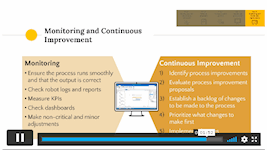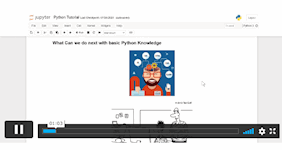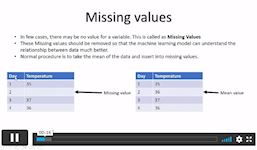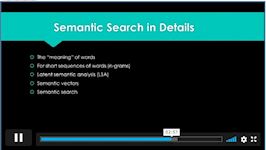Robotics
Summer Flash Sale | 5 Certified Courses Bundle | Premium Video Tutorials | Lifetime Access | 24/7 Expert Support
Course Cloud
Summary
- Exam(s) / assessment(s) is included in price
- Tutor is available to students
Overview
***Offer Ending Soon***
Our comprehensive course on Robotics will assist you to produce the best possible outcome by mastering the necessary skills and enhancing your chances of landing your dream job in the relevant sector. Develop in-demand professional skills by enrolling in our Robotics bundle & get 5 premium courses with a single payment.
Courses are included in this Robotics Complete Bundle:
- Course 01: Advance Robotic Process Automation
- Course 02: Python from Scratch Level 3
- Course 03: Python Data Science Level 1
- Course 04: Level-3 Machine Learning Course with Python
- Course 05: Complete U&P AI - Natural Language Processing (NLP) with Python
Learn at your own pace from the comfort of your home as the rich learning materials of these bundle courses are accessible from any place at any time. The advanced course curriculums are divided into tiny bite-sized video modules by industry specialists with years of experience behind them. Throughout your learning journey with Course Cloud, you'll receive expert tutor support, and our friendly customer service is available 24/7 to answer any questions you may have.
Upon completion, you'll be awarded a certificate to showcase your expertise. Boost your resume and stand out in the crowd by adding these valuable skills & kickstart your career in the right direction.
There is no prior requirement or experience needed to enrol in our Robotics. You only need the willingness to learn new skills and eagerness to practise. You can access the course materials at any time with any internet-enabled device and keep developing new skills.
So enrol today & do your best! As what you plant now, you will harvest later. Become the person who would attract the results you seek. Grab this opportunity and start learning!
CPD
Course media
Description
Curriculum of Robotics Bundle
***Course 01: Advance Robotic Process Automation***
Section 01: Introduction
- Introduction to Robotic Process Automation
Section 02: What is RPA and How Does it Work
- Section Introduction
- RPA –What it is and How it Works
- RPA – Why now
- RPA – Pros
- RPA – Cons
- RPA – Vendors
- RPA – Case Study
Section 03: Build Your First Robot!
- Section Introduction
- The UiPath Platform
- Install UiPath Studio (Developer Software)
- Get to Know UiPath Studio – Part 1 (First Look)
- Get to Know UiPath Studio – Part 2 (First Project)
- Build a Robot – Part 1 (The Case)
- Build a Robot – Part 2 (The Challenge)
Section 04: Pilot RPA in Your Enterprise
- Section Introduction
- A Basic Plan for Piloting and Implementing RPA
- Step 1 – Identify, Evaluate and Prioritize Processes
- Step 2 – Describe Processes
- Step 3 – Design, Develop and Test
- Step 4 – Implement Processes
- Step 5 – Monitoring and Continuous Improvement
- Create an RPA Center of Excellence (CoE) – Part 1 (Roles & Responsibilities)
- Create an RPA Center of Excellence (CoE) – Part 2 (Governance Model)
- Critical Success Factors
- More Real-World Applications of RPA
Section 05: Further Learning
- Further Learning
- Course Summary
***Course 02: Python from Scratch Level 3***
Introduction
- Welcome to the Course
- Lets get started with Python
- Python Expressions and Operations
Get Deeper into Python
- Python Data Types – List and Tuples
- Python Data Types – Dictionary
- Python Loops
- Python Functions
- Handling Exceptions and Conditional Statements
Analytics with Python
- Introduction to Analytics
- Understand Data with Python
- Get Started with Analytics
***Course 03: Python Data Science Level 1***
Unit 01: Introduction to Python Data Science
- Module 01: Introduction to Python Data Science
- Module 02: Environment Setup
Unit 02: Data Cleaning Packages
- Module 01: Numpy package for calculations
- Module 02: Panda package for Data cleaning
Unit 03: Data Visualization packages
- Module 01: Matplotlib Data Visualization Part 1
- Module 02: Matplotlib Data Visualization Part 2
***Course 04: Level-3 Machine Learning Course with Python***
Module 01: Introduction to Machine Learning Algorithms
- Introduction to types of ML algorithm
Module 02: Preprocessing
- Importing a dataset in python
- Resolving Missing Values
- Managing Category Variables
- Training and Testing Datasets
- Normalizing Variables
- Normalizing Variables – Python Code
- Summary
Module 03: Regression
- Simple Linear Regression – How it works?
- Simple Linear Regreesion – Python Implementation
- Multiple Linear Regression – How it works?
- Multiple Linear Regression – Python Implementation
- Decision Trees – How it works?
- Random Forest – How it works?
- Decision Trees and Random Forest – Python Implementation
Module 04: Classification
- kNN – How it works?
- kNN – Python Implementation
- Decision Tree Classifier and Random Forest Classifier in Python
- SVM – How it works?
- SVM – Python Implementation
***Course 05: Complete U&P AI - Natural Language Processing (NLP) with Python***
Unit 01: Getting an Idea of NLP and its Applications
- Module 01: Introduction to NLP
- Module 02: By the End of This Section
- Module 03: Installation
- Module 04: Tips
- Module 05: U – Tokenization
- Module 06: P – Tokenization
- Module 07: U – Stemming
- Module 08: P – Stemming
- Module 09: U – Lemmatization
- Module 10: P – Lemmatization
- Module 11: U – Chunks
- Module 12: P – Chunks
- Module 13: U – Bag of Words
- Module 14: P – Bag of Words
- Module 15: U – Category Predictor
- Module 16: P – Category Predictor
- Module 17: U – Gender Identifier
- Module 18: P – Gender Identifier
- Module 19: U – Sentiment Analyzer
- Module 20: P – Sentiment Analyzer
- Module 21: U – Topic Modeling
- Module 22: P – Topic Modeling
- Module 23: Summary
Unit 02: Feature Engineering
- Module 01: Introduction
- Module 02: One Hot Encoding
- Module 03: Count Vectorizer
- Module 04: N-grams
- Module 05: Hash Vectorizing
- Module 06: Word Embedding
- Module 07: FastText
Unit 03: Dealing with corpus and WordNet
- Module 01: Introduction
- Module 02: In-built corpora
- Module 03: External Corpora
- Module 04: Corpuses & Frequency Distribution
- Module 05: Frequency Distribution
- Module 06: WordNet
- Module 07: Wordnet with Hyponyms and Hypernyms
- Module 08: The Average according to WordNet
Unit 04: Create your Vocabulary for any NLP Model
- Module 01: Introduction and Challenges
- Module 02: Building your Vocabulary Part-01
- Module 03: Building your Vocabulary Part-02
- Module 04: Building your Vocabulary Part-03
- Module 05: Building your Vocabulary Part-04
- Module 06: Building your Vocabulary Part-05
- Module 07: Dot Product
- Module 08: Similarity using Dot Product
- Module 09: Reducing Dimensions of your Vocabulary using token improvement
- Module 10: Reducing Dimensions of your Vocabulary using n-grams
- Module 11: Reducing Dimensions of your Vocabulary using normalizing
- Module 12: Reducing Dimensions of your Vocabulary using case normalization
- Module 13: When to use stemming and lemmatization?
- Module 14: Sentiment Analysis Overview
- Module 15: Two approaches for sentiment analysis
- Module 16: Sentiment Analysis using rule-based
- Module 17: Sentiment Analysis using machine learning – 1
- Module 18: Sentiment Analysis using machine learning – 2
- Module 19: Summary
Unit 05: Word2Vec in Detail and what is going on under the hood
- Module 01: Introduction
- Module 02: Bag of words in detail
- Module 03: Vectorizing
- Module 04: Vectorizing and Cosine Similarity
- Module 05: Topic modeling in Detail
- Module 06: Make your Vectors will more reflect the Meaning, or Topic, of the Document
- Module 07: Sklearn in a short way
- Module 08: Summary
Unit 06: Find and Represent the Meaning or Topic of Natural Language Text
- Module 01: Keyword Search VS Semantic Search
- Module 02: Problems in TI-IDF leads to Semantic Search
- Module 03: Transform TF-IDF Vectors to Topic Vectors under the hood
Certification
Once you have successfully completed the course, you will be awarded a certificate of completion as an evidence of your achievement. The certificate is recognised both nationally and globally by potential employers of relevant industries. You have the option to choose a PDF certificate for just £4, or hard copy certificates at a £12 processing fee, or both.
Who is this course for?
Anyone with an interest in Robotics will find these courses really valuable. Whether you are a student/professional aiming to explore your opportunities in relevant job sectors then this bundle course is the perfect opportunity for you.
Questions and answers
Currently there are no Q&As for this course. Be the first to ask a question.
Reviews
Currently there are no reviews for this course. Be the first to leave a review.
Legal information
This course is advertised on reed.co.uk by the Course Provider, whose terms and conditions apply. Purchases are made directly from the Course Provider, and as such, content and materials are supplied by the Course Provider directly. Reed is acting as agent and not reseller in relation to this course. Reed's only responsibility is to facilitate your payment for the course. It is your responsibility to review and agree to the Course Provider's terms and conditions and satisfy yourself as to the suitability of the course you intend to purchase. Reed will not have any responsibility for the content of the course and/or associated materials.






